Some of the rarest types of monkeys in the world are white. Their white hairs can cover the entire body or they may only cover a significant part of the body.
Almost all species can be white in rare cases of albinism. However, most white monkeys are known on a per-species basis.
The white nuance may be specific to both males and females of a species or it may change over time.
It’s not uncommon for monkeys to be white or brighter when young and darker when older.
White monkeys live in different habitats from the rainforest to savannahs, and grassland.
Many of these monkeys are rarely seen on the ground where their brighter appearance would put them in front of more potential predators easier.
Others are so well adapted to social and urban living they may even live among humans, often begging for food or attention.
As a rare type of monkey, they may also suffer from illegal hunting when it comes to their direct interaction with humans
The following species of monkeys are found in The Amazon Basin, in equatorial Africa, India, or other Southeast Asia habitats, often in high numbers.
Table of Contents
1. White-Mantled Tamarin
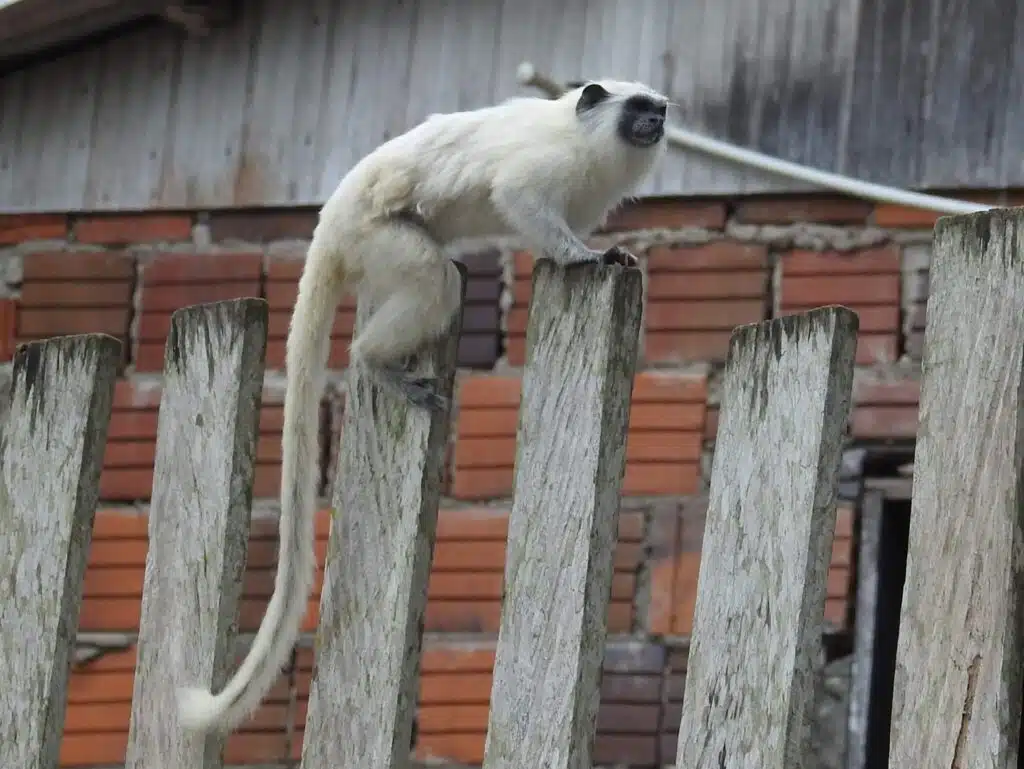
A South American native, White-Mantled Tamarins (Saguinus weddelli) are endemic to Brazil.
Living in the Western part of The Amazon Basin, White-Mantled Tamarins are also a small species.
It grows to 6-8 inches and is characterized by all-white hairs across its body.
Its head, legs, tail, and underside are all-white. Gray skin-only sections with a few white scarce hairs are also seen on its face.
Both terrestrial and arboreal, White-Mantled Tamarins rarely live in remote areas on their own as they’re often spotted with other types of tamarins.
Finding this monkey is easier given it congregates with Emperor tamarins and other tamarins.
Unlike other monkeys, on the other hand, White-Mantled Tamarins may also live on their own, especially in the case of males.
Group living is more common. A group with a single male or a group without males are some of the basic forms of socializing for these monkeys.
There are other types of groups where males live together as well.
A form of hereditary White-Mantled Tamarin group also exists. Females born within a group may stay within the same group, with or without one male counterpart.
2. Silvery Marmoset
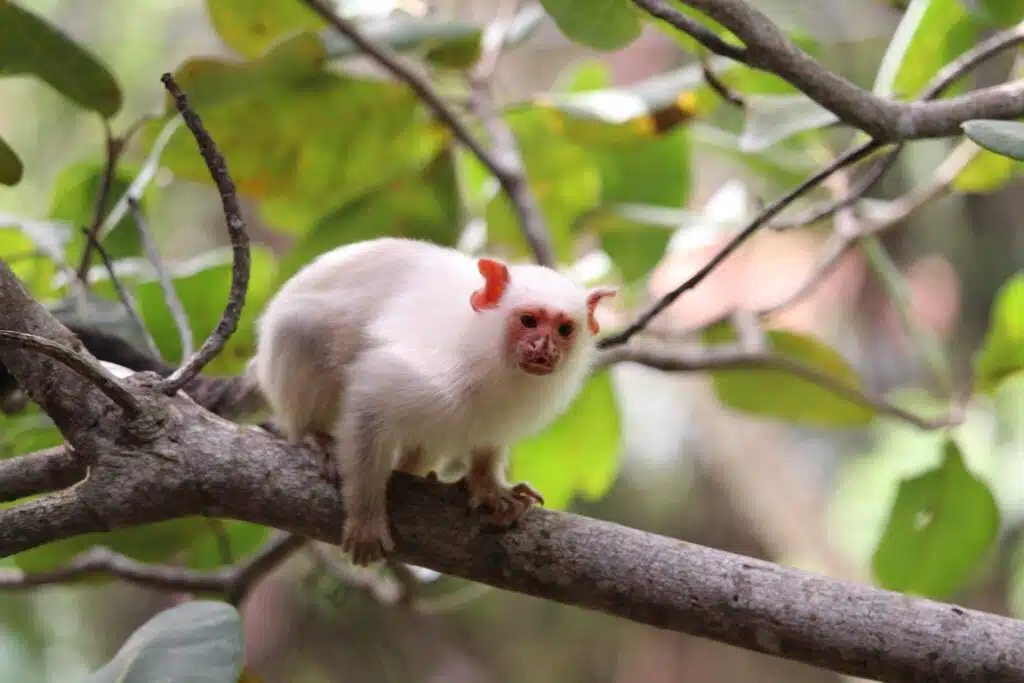
A species of South America, Silvery Marmosets (Mico argentatus) are present in The Amazon Rainforest, particularly in Brazil.
These monkeys feature an all-white nuance with a sheen to their hair which almost makes them silvery.
A small species, Silvery Marmosets only grow to 11 inches, at best.
Their reduced size means these types of white monkeys can hide from potential predators easily.
They prefer to retreat into tree cavities at night and always live in groups for extra protection.
Silvery Marmosets use different group vocalizations to steer potential predators away.
A species that spends all of its life up on trees, Silvery Marmosets survive on sweet tree sap. They can also eat vertebrates, and invertebrates at times.
3. Tufted Gray Langur
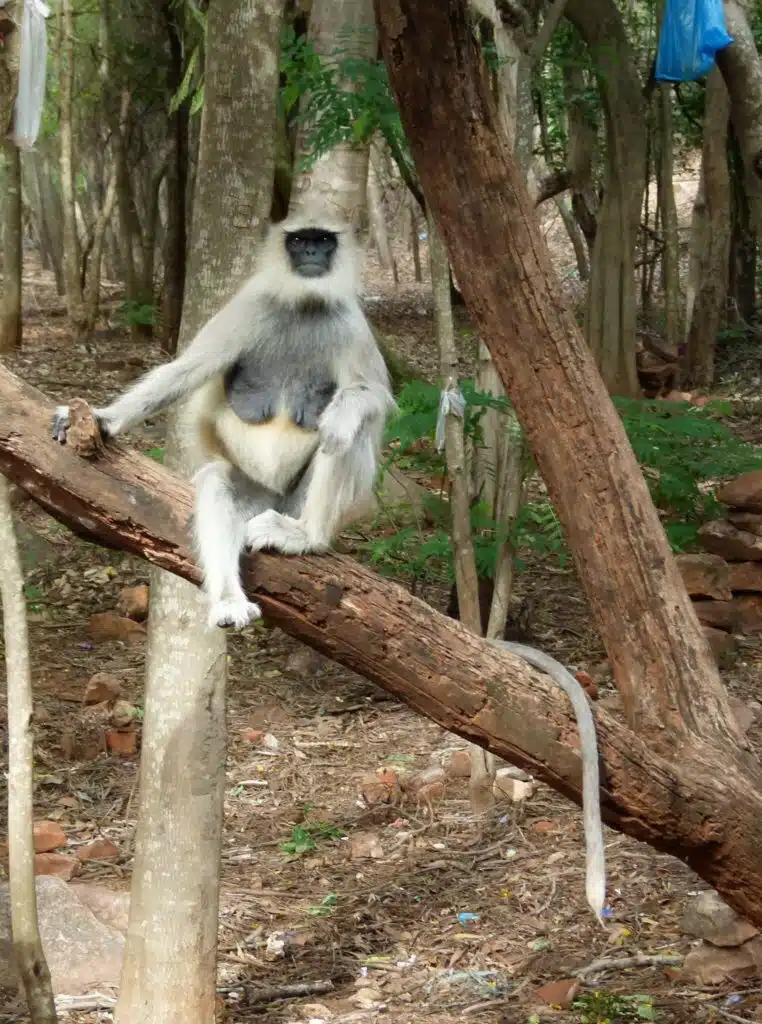
Mostly gray and white, The Tufted Gray Langur (Semnopithecus priam) has a white beard and white hairs on its crown.
This is a large species that grows to 30 inches which also shows white hairs on its chest and belly.
While its back and arms are gray, they still show long scarce white hairs.
Tufted Gray Langurs are one of the species native to India and Sri Lanka.
It lives in forests, typically in large groups. Up to 50 males and females can live within a group, under the rule of a leader male and female.
These types of groups are particularly common around trees they feed on such as The Indian Fig, providing them with the leaves they like to eat.
Fruits of their favorite trees are also part of their diet.
A species that eats fruits, seeds, leaves, and roots, these types of monkeys often fall prey to various predators such as eagles.
While they cannot properly defend themselves, they are known to mix with other species which can detect predators earlier.
These monkeys may live among Spotted Deer, a species with a keen sense of smell that helps detect predators in the area early.
Some of the sounds these monkeys make when a predator is approaching include barks and whistles.
4. Golden-White Bare-Ear Marmoset
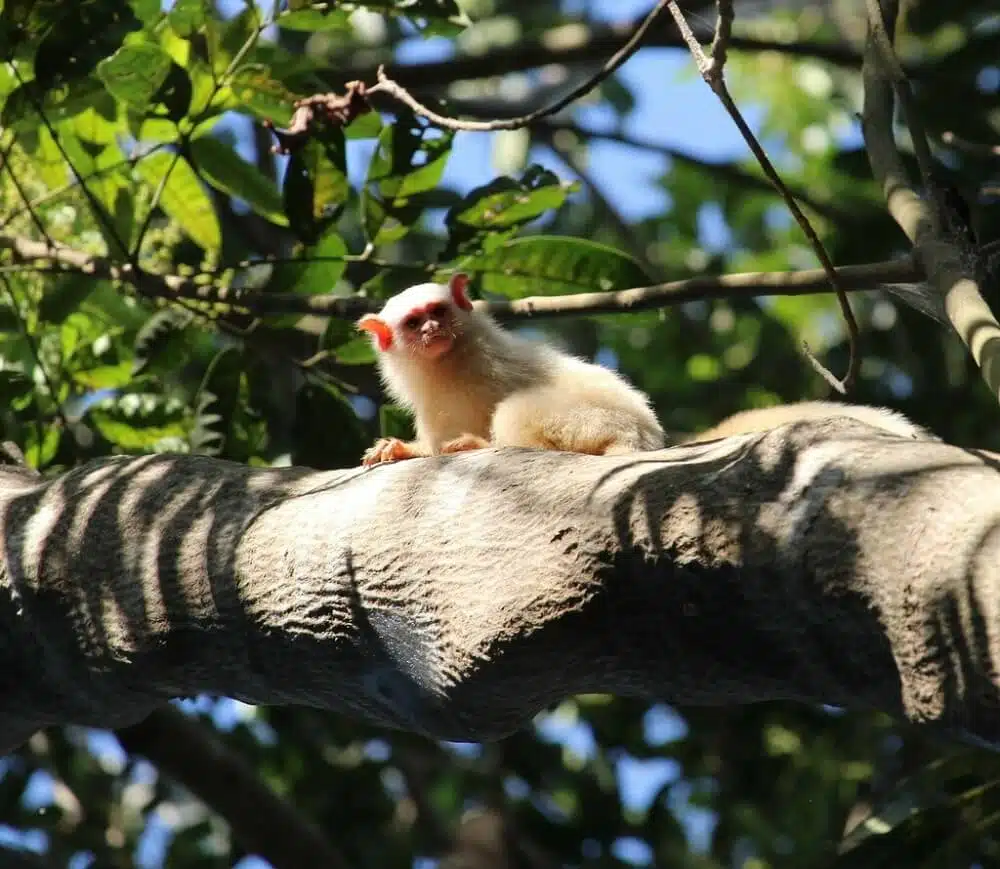
Some of the oldest types of white monkeys in the world are The Golden-White Bear-Ear Marmosets (Mico leucippe).
These monkeys have a cream-white or white-to-golden nuance across the body and tail.
Pink faces and ears are specific to the species and are among the few areas of the body that aren’t covered in hair.
Some of the hairs of the species are much more important than appearance purposes. The hairs around the legs have tactile purposes.
A species with claws and long teeth, Golden-White Bear-Ear Marmosets are known to have a diverse plant-based diet.
Tree sap is an important food source for this species which can chew its way through bark to get to its favorite food.
Monkeys of this species are mostly found around the trees of the rainforest that offers the best type of sap.
They tend to live in groups, often with just a few breeding males and females, together with their young.
In some cases, the elderly are also part of the group but they may move out on their own as well.
Groups of these monkeys inhabit the upper canopy where there’s plenty of food and where there are fewer predators such as snakes.
5. Brazilian Bare-Faced Tamarin
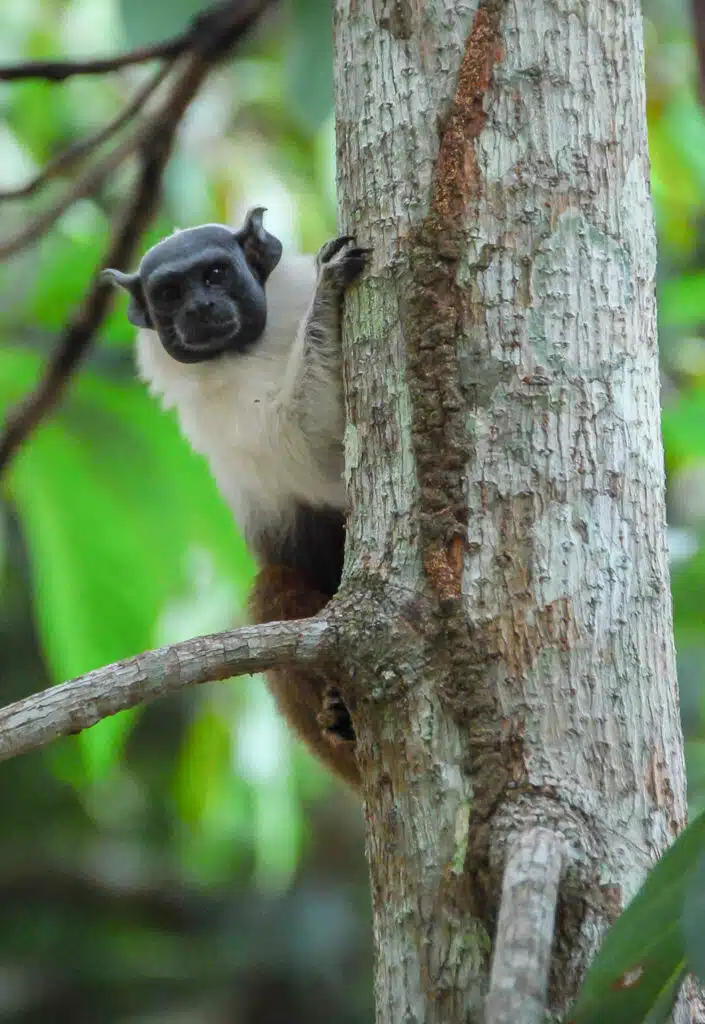
Partly white, The Brazilian Bare-Faced Tamarin (Saguinus bicolor) is one of the multiple numerous species of Brazil’s rainforest.
There’s a white-brown hair color split on this type of tamarin.
This is a species that features a white upper body, a black head, and a brown lower body with a tail.
Found in the deep rainforest, this is a species that eats almost anything it can find, from fruits to leaves or bird eggs.
A common species around the jungle city of Manaus, this is also one of the rainforest monkeys with claws and nails.
Apart from helping it with food, this physical trait allows them to be very quick climbers.
Since they’re only found around urban areas of the forest, The Brazilian Bare-Faced Tamarin is also endangered through industrialization.
Fragmentation and even destruction of its habitat is its highest concern.
This type of monkey is also short-lived compared to others in Brazil as it may only live up to 10 years.
6. Geoffroy’s Tamarin

The mostly white coloring is specific to Geoffroy’s Tamarin. This (Saguinus geoffroyi) is a species with a red back collar, a black back, and a matching head.
With its white chest and legs, this is a small monkey of the Northern forests of South America.
The species has a few other rare traits, apart from its white nuance.
For example, while arboreal. Geoffroy’s Tamarins can still be spotted on the ground. They may climb down from trees looking for food.
A very small social group is also specific to these monkeys. They may live in groups as small as 5 monkeys.
Both males and females are part of this group and they may breed among them.
A dominant female breeding with all males of the group is more common, on the other hand.
While offspring are born, they are cared for by all group members, including male monkeys.
Native to Panama, the monkey prefers new and old forests. It lives in medium-humidity forests and it cannot be found in the highest-humidity forests of South America
7. Cotton-Headed Tamarin

Mostly white on the head, chest, and front legs, Cotton-Headed Tamarins (Saguinus oedipus) are small and well-known white monkeys.
Apart from their white and partly brown appearance, these monkeys show different social behaviors and a capacity to show dominance over others when living in groups.
Female Cotton-Headed Tamarins show dominance over other females by preventing them from breeding.
Males show dominance over other males by clicking them out of their group or by being the only ones mating in the group.
Native to the forests of the Northeastern parts of South America, these types of monkeys are also considered intelligent, not just reactive.
They possess an array of vocalizations and grimaces used in daily communication.
Some evidence already shows these communication cues aren’t innate but that the offspring has to learn them over time.
These complex vocalizations can even identify a member of the group that is in trouble.
As they mature, these monkeys also get long white hairs on their heads, creating a mantle-like appearance.
They can keep these hairs clean by cooperating among them.
However, spiteful behavior is more common for this species than others, often resorting to not communicating and even punishing other monkeys for various reasons.
8. White-Thighed Surili
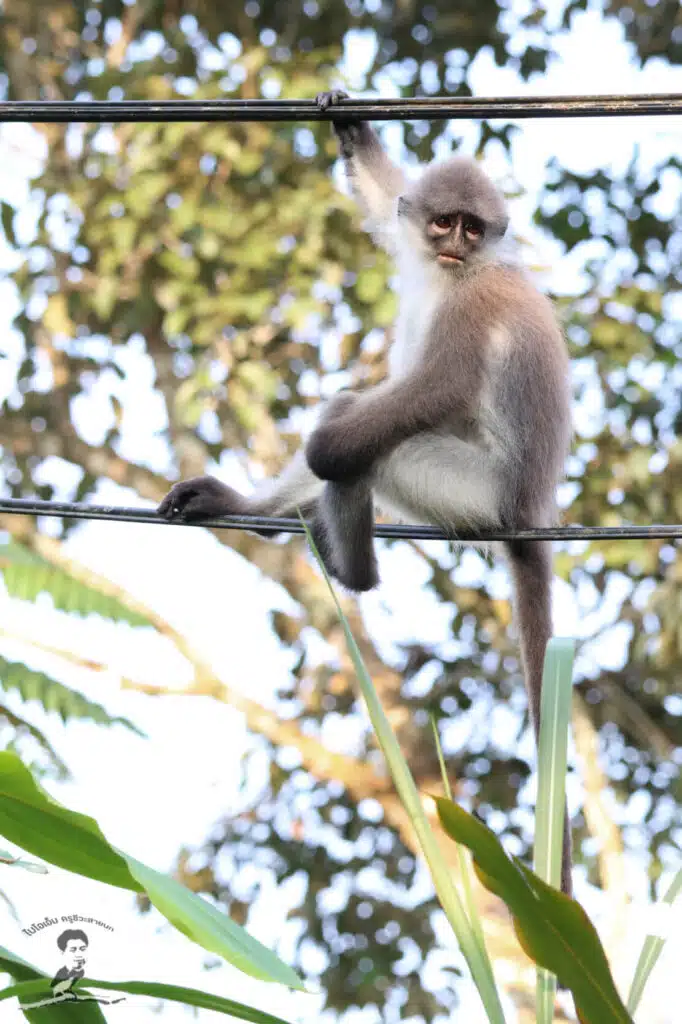
Named after its white legs, The White-Thighed Surili (Presbytis siamensis) is a mostly white species with black sections, such as its face.
A species of The Thai-Malay Peninsula, these types of monkeys are mainly arboreal, with occasional terrestrial adventures to crops and gardens.
These types of white monkeys live in groups, often forming close relationships with all group members.
This is best seen when the rest of the group takes care of the young.
A species found in moist areas of the forest such as next to swamps, White-Thighed Surilis also live in Sumatra, where they feed on leaves and fruit.
These black-faced white monkeys can live up to 18 years in Sumatra and a bit less in other areas of their region.
9. Gee’s Golden Lutung
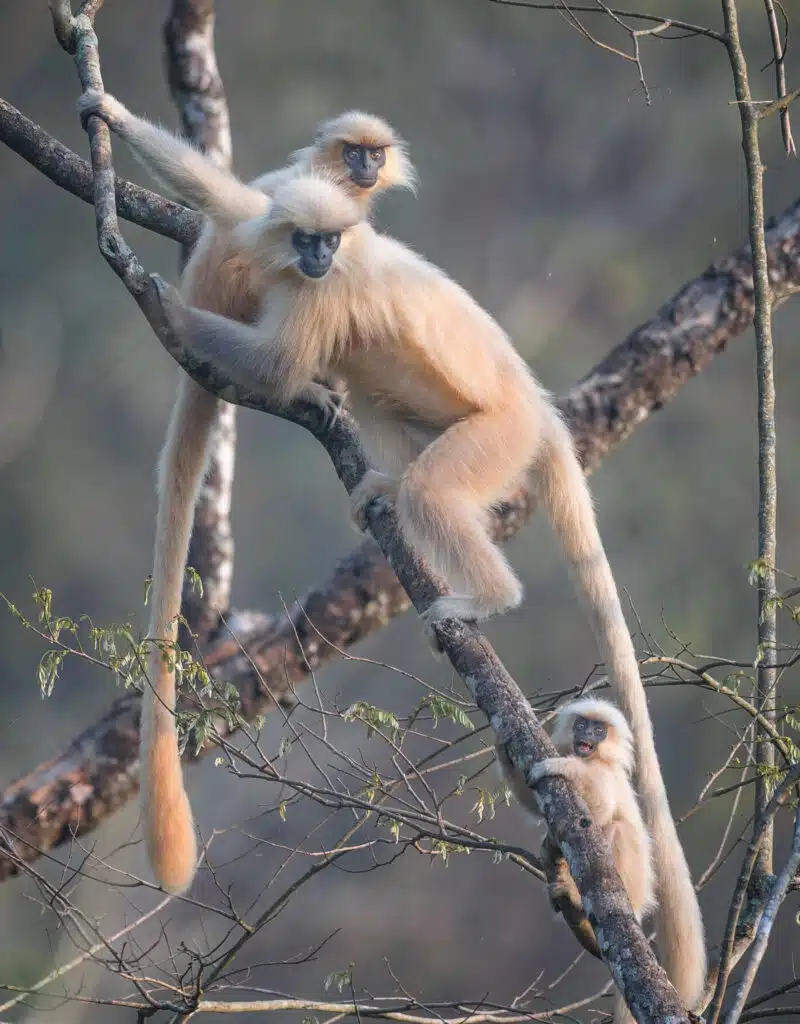
One of the rarest white monkeys in the world, Gee’s Golden Lutung (Trachypithecus geei) is native to East India and a small mountainous region in Bhutan.
This is one of the monkeys that changes colors with the seasons.
It has a white appearance during the summer and a chestnut, rust, or orange rust in the winter.
Females of the species are always brighter while the radial hairs around their faces are also white, throughout the seasons.
These hairs around the face are believed to protect their faces from the heavy rain in their native area.
Mostly found in Assam, these types of monkeys have black hairless faces and brown eyes.
They live in mixed groups where males are identified by their larger size.
Mixed groups are specific to these monkeys. There are always more females than males in a group and all of them can breed with each other.
The diet of the monkeys is also diverse. Food choices often start with fruits and leaves but may even include flowers.
An arboreal species, the monkey rarely climbs down to the ground.
Certain adaptations such as drinking rainwater collected on leaves allow it to live all of its lives in a higher canopy.
10. Rylands’ Bald-Faced Saki

There are different degrees of white hairs covering the body of adult Rynalds’ Bald-Faced Sakis (Pithecia rylandsi).
These types of monkeys are mostly black and white their whole lives. Then they turn mostly white, as they age.
Native to Peru, Bolivia, and Brazil, these large sakis also show black and white legs and a fluffy black and white tail.
Much of their appearance is tied to the trees and forests they live in, as they spend a lot of time on whitebark trees.
These monkeys are also known for their all-black faces and their tendency to live up on trees in dense areas.
They resort to living in these areas for food but also to avoid being prey for snakes and other predators.
Eagles are considered the largest predator to Rynalds’ Bald-Faced Sakis while deforestation is seen as the biggest threat to the survival of the species.
Growing to a maximum size of 16 inches, these types of monkeys live next to rivers, areas where eagles are on the lookout for their next meal.
This is also where these monkeys feed on fruit seeds. They are also seen as an important element in the ecosystem as they spread these seeds along rivers.
The unique black-and-white appearance of these monkeys is also known to be a threat to their very existence mainly through the rise in illegal hunting.
11. White-footed Saki

Cream-white nuances are specific to White-Footed Sakis (Pithecia albicans). These types of monkeys have a fluffy appearance due to their long white hairs.
A white face covered in short white hair is also specific to this species.
Some brown areas are also seen on the species, mainly along the legs.
An interesting lifespan is specific to the species which can live a very long life in captivity but which may fall prey to forest predators in the wilderness.
White-footed Sakis can live almost 40 years in captivity.
The fluffy appearance of this species may also be tied to its long life as these types of monkeys try to look bigger in the face of a predator as a means of escape.
One of the ways they do this is by raising their hair and elevating their chests in front of predators.
A species of The Amazon, this is an arboreal type of monkey that occasionally climbs down for food such as fruits and seeds.
While not much is known about the specifics of their communication and intelligence, these monkeys are known to live in small groups as well as pairs.
Even the larger groups of the species barely number 6 males and females, which may breed between them.
The existence of pairs also signals these types of monkeys can form monogamous relationships.
Mostly territorial in the breeding period, males of the species can urinate to mark their territory or to attract females.
Soon after breeding, the female gives birth to the offspring which continues living within the group for the first few months.
Once the offspring can find its food, it tends to leave the group.
The presence of multiple offspring as well as having siblings is also a time to see both males and females provisioning for a period of up to 5 months.
These monkeys tend to live with their parents until their teeth are properly developed as well.
Many of the fruits they consume require hard long teeth to crack them open.
12. Golden-White Tassel-Ear Marmoset

Mostly white and partly golden brown, this type of monkey (Mico chrysoleucos) is one of the smaller species of The Amazon.
Only living in a remote area of The Amazon Basin, the Golden-White Tassel-Ear Marmoset has a white head, white ears, a white chest, and a back.
The lower part of its back, its hindlegs, and its tail have a darker golden nuance.
Both arboreal and terrestrial, the marmoset typically avoids climbing down where there are more predators to worry about.
Often smaller than 10 inches (without tail), this monkey is more vulnerable to predation than others.
Golden-white tassel-ear Marmosets live in groups of up to 20 monkeys up on trees.
Both males and females are part of these groups where they form monogamous relationships that last.
While small, the monkeys are highly territorial, rarely allowing other monkeys or species to make it into their area.
They can make different sounds or buff up their chests to show their dominance over their territory.
The vocalizations or alarm sounds these monkeys use differ depending on the situation. They may be vocal about a predator or scratch their chests about other marmosets in the area.
13. Black-And-Gold Howler
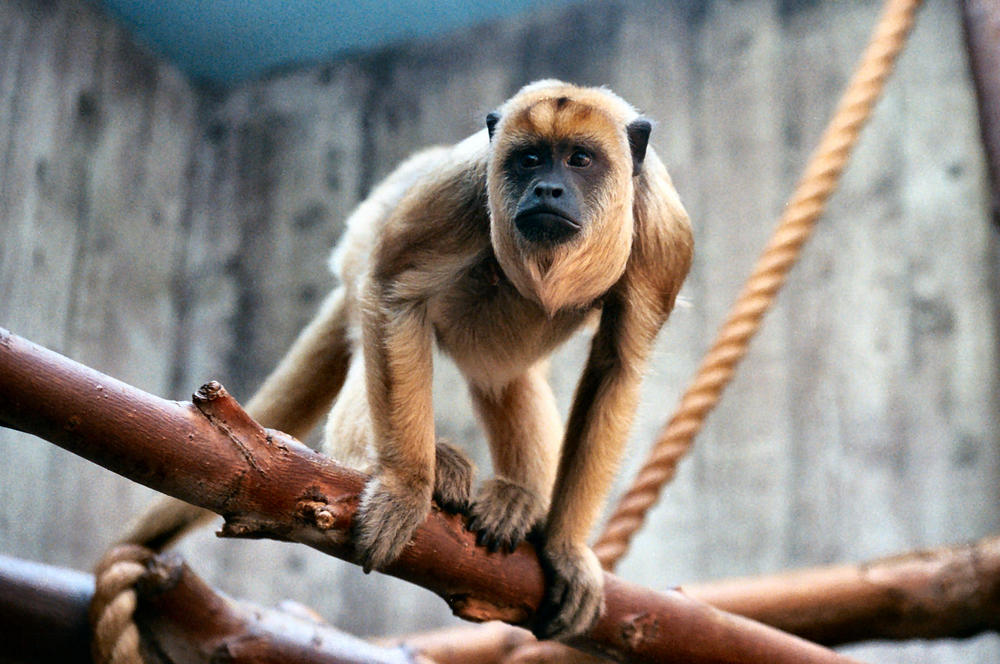
A species of South America, Black-And-Gold Howlers (Alouatta caraya) are native to Brazil, Peru, Bolivia, and Argentina.
Males and females of the species have opposing coloring which inspires their name. While males are black, females and juveniles have a bright golden color which may darken slightly over time.
Males of the species are also larger than females.
A typical howling sound is also what these monkeys are known for. These are some of the loudest types of monkey vocalizations in South America.
Their purpose is mostly to assert dominance and territoriality and not so much to attract the opposite sex as the females of the species are the ones initiating the breeding.
Female Black-And-Gold Howlers choose the male they want to breed with and follow around. They can even touch the male to initiate and communicate their desire to breed.
Each group has a dominant male and females tend to breed with this male.
The numbers of these monkeys are large in some areas of their range and diminishing in urbanized areas.
Some of the most remote areas are known to have the highest numbers of these monkeys.
Areas along the second largest river in The Amazon, The Parana River, are known to attract the highest Black-And-White Howler populations
14. Olive Baboon
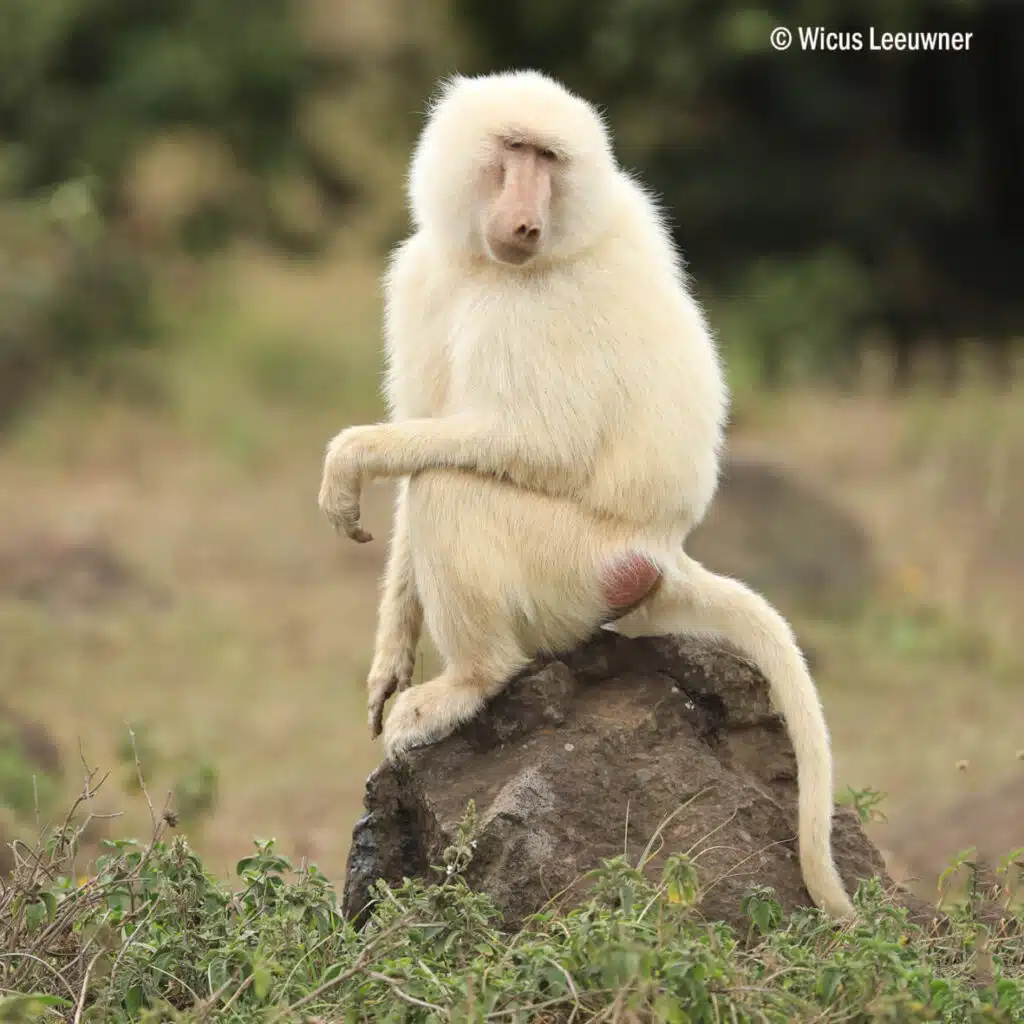
A widespread species of Africa, The Olive Baboon (Papio anubis) is mostly olive. However, there are rare instances when this baboon is completely white.
These white morph Olive Baboons also have brighter pink faces rather than their more common red faces.
Baboons of this species live within equatorial Africa in more than 20 countries.
They represent some of the most adaptable types of monkeys and baboons in the world as they forage in the canopy and on the ground.
Forests and grassland are among their typical habitats. These monkeys may also adapt to the different types of food they can forage in these distinct habitats.
Multiple types of vocalizations including howling and screaming are specific to these monkeys.
They resort to these vocalizations when startled or when asserting dominance over other group members.
Very large groups of up to 150 members are specific to Olive Baboons.
These groups are dominated by basic grunt noises made by males daily.
The group itself is dominated by a male and female hierarchy where the most important members get to make important decisions and get the first breeding right.
While there’s a clear male hierarchy in each group, males may still challenge themselves over breeding with younger females.
15. Albino Monkeys

Albinism is a condition also specific to monkeys. Known as a lack of pigmentation, it results in all-white monkeys with white hairs and pale skin.
This is caused by the genetic inheritance of both albino parents. A monkey with just one albino parent doesn’t become white itself but it still carries the albinism gene and may produce albino offspring when mating with another albino monkey.
This is a rare condition that also negatively impacts monkeys which may even suffer from various skin conditions more than a regular monkey.
White hairs are mostly all-white in an albino monkey. Exceptions do apply, depending on each species.
An Olive Baboon can be albino and all-white. Some types of gorillas may also be all-white.
Capuchin monkeys that are albino may not be all-white but partly white, mainly in the upper area of the body.
While albino monkeys can look different depending on their species, they may all suffer from the same drawbacks that come with the condition.
Poor vision is among them. Nearsightedness and farsightedness are among the typical conditions they face when it comes to vision problems.
Becoming less camouflaged tends to be an even bigger problem. A white monkey stands out in the dense jungle immediately.
This means predators such as snakes or hawks can immediately locate an albino monkey almost over any other color monkey.
While not a life-threatening result of albinism, group discrimination is also faced by albino monkeys.
A completely different appearance to the rest of the group may even lead to monkeys being isolated or kicked out of the group as a form of primate discrimination.